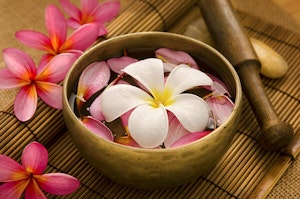 Be Inspired Blog - Arizona
Be Inspired Blog - Arizona
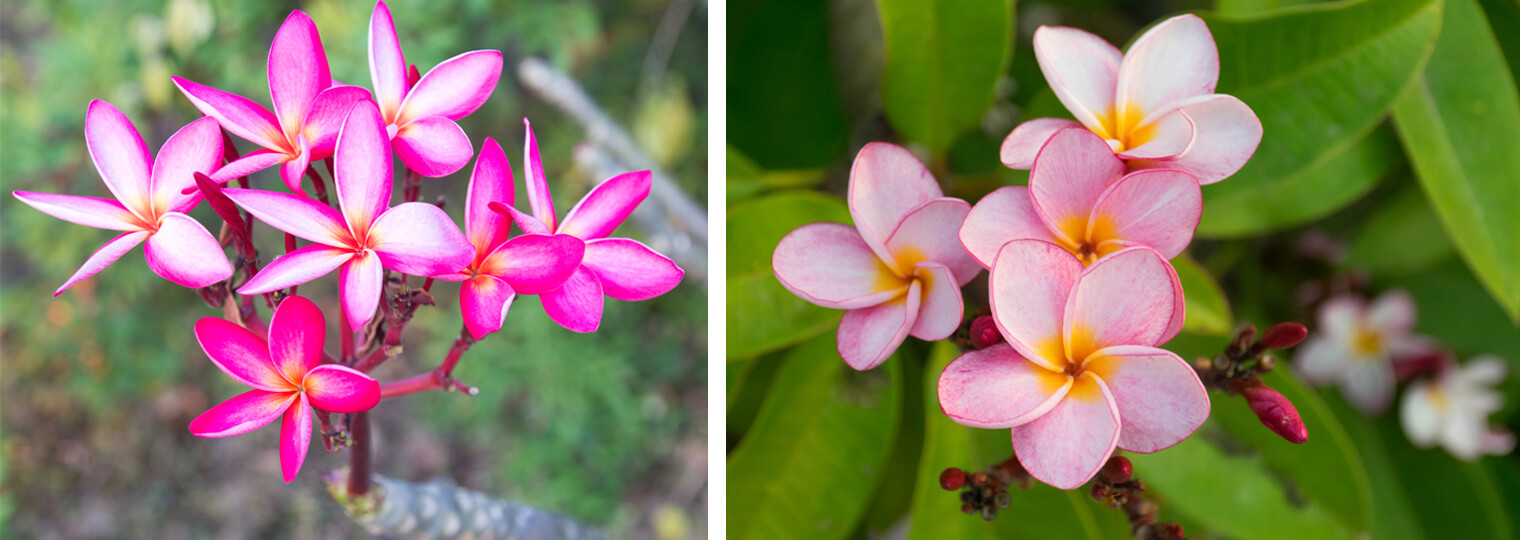
How to Grow & Care for Plumeria
Do you need a new and beautiful plant to grace your garden? One of our top recommendations is the gorgeous, delightfully fragrant plumeria—also known as frangipani.
Keep reading to find out what they are, how to care for them, and how to grow them—particularly in containers.
What Do Plumerias Look Like?
Plumerias have thick stems and even leaves that feel like leather. They also grow a ton of flowers from early summer until the fall season, making this the perfect time to add one to your space.
There are many flower colors and variations available. In Maricopa County, plumerias are best planted in containers. Plumeria flowers can be floated in a bowl of water for a stunning table-top display.
In addition to their stunning appearance, you’ll also enjoy the sweet scents they put off—including rose, jasmine, gardenia, citrus and more...
Caring for Plumeria
Climates & Microclimates
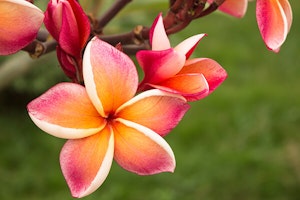 As Phoenix Tropicals notes, although plumeria is thought of as tropical, they are able to tolerate temperatures down to freezing—and perhaps a little cooler for a very short duration of time. With a good microclimate, plumeria can grow well in the valley. You may not realize that different areas of town are warmer than others.
As Phoenix Tropicals notes, although plumeria is thought of as tropical, they are able to tolerate temperatures down to freezing—and perhaps a little cooler for a very short duration of time. With a good microclimate, plumeria can grow well in the valley. You may not realize that different areas of town are warmer than others.
We recommend growing rubra varieties of plumeria. Rubra plumerias have duller pointed leaves and colorful flowers. According to Phoenix Tropicals, "Rubra plumerias are more hardy and heat tolerant than obtusa (varieties) and are therefore a better fit for outdoors in Phoenix with its temperature extremes." During the hottest and driest months in Phoenix, plumeria will likely have some burnt leaves (similar to citrus plants). Phoenix Tropicals adds that, "The flowers do not take the heat as well as the leaves and for this reason a rubra will be more attractive if it gets afternoon shade. If moving a plumeria from shade to sun be sure to do so gradually. Like all plants, plumerias will burn if suddenly moved from a low light to a high light environment."
Plumeria are very sensitive to cold, which is why they’re so great to grow during the summer. Make sure you protect yours from frost and freezing temperatures—in the 30°F's and below 30°F. Bring containers indoors or move them underneath a patio overhang and wrap with frost cloth for extra protection. If planted in the ground, use frost cloth to protect plumeria from frost and freezing temperatures.
Watering
In the summer in Phoenix, we recommend that you water your potted plumeria at least twice a week—more frequently if needed. Remember, plants in containers will dry out faster than those planted in the ground. Be careful not to over water or the trunks will rot.
We recommend that you reduce the watering of plumerias in mid-fall as plants start going dormant, and stop watering during the winter; do not let your plant freeze. Once new growth appears in the spring, resume regular watering.
 Fertilizing
Fertilizing
As soon as your plumeria shows signs of spring growth, begin fertilizing. Encourage flower bud formation by using a high phosphorous fertilizer, such as Grow More Hawaiian Bud & Bloom, and apply it every 2-3 weeks through August. Plumeria flower mid-summer to fall. When they bloom, you can snip flowers for bud vase bouquets or float the blossoms in a low bowl of water (which is a stunning, beautiful look). This does not hurt the plants and will provide a supply of attractive fragrant flowers to use around your home.
Pruning, Propigating & Pests
Very little pruning may be required in springtime. Gardening Know How also suggests that, “Any drastic or hard pruning done may reduce flowering. These plants can also be propagated by seeds or cuttings in spring, with cuttings being the easiest and most preferred method."
We recommend that you insert cuttings approximately 4-6 inches in the potting mix and lightly water. Please note that cuttings need to dry out on their ends prior to inserting them in the soil. It usually takes them a few days to dry out enough.
Also, watch out for spider mites, white flies, mealybugs and other pests that can cause problems. SummerWinds Nursery's Trusted Garden Advisors can answer questions about how to protect your plumeria from these types of insects. To deter insects, we recommend that you wash the leaves when watering.
Growing Plumeria in Containers
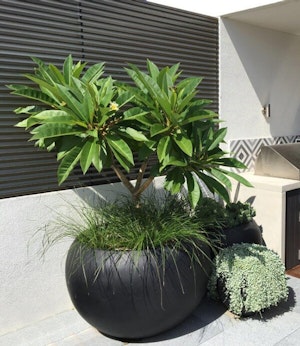
SummerWinds recommends planting plumeria in containers, such as pots, barrels, tubs and urns. Plumeria does best in part-sun with its canes protected from the extreme heat of the sun in Arizona. In order to help control the microclimate of your plumeria, you can move your container around, based on the season and the weather. We do not recommend keeping/growing your plumeria indoors; a shaded patio is ideal!
For more on how to successfully grow plumeria in containers, we love these growing tips from Easy to Grow Bulbs:
- Place your plumeria where it will receive part sun. These are tropical plants that like hot conditions. (For success in Maricopa County, SummerWinds recommends planting your plumeria so that it receives morning sun—until 11:00 a.m. or noon. Alternatively, you can plant them where they will receive bright filtered shade.)
- Fill your containers with good quality, light and porous soil that allows for excellent drainage. SummerWinds Nursery recommends E.B. Stone Naturals Cactus Mix. Make sure your container has adequate drainage holes; plumeria must never (never!) sit in waterlogged soil or they will die.
- Gently pull the plant and root ball out of the pot and place in a hole the same depth as the clump of soil. Firmly press the surrounding soil around the plant, checking to make sure the plumeria is settled, level with the surrounding soil; not deeper or shallower.
- After planting, add enough water to settle the soil around the root ball; the slim, leathery leaves will form within a couple weeks. If it doesn't rain, make sure to water enough for a good drink, but allow the soil to dry out between watering. Infrequent deep watering is better than regular light drinks.
- Apply fertilizer (as indicated in the section above). Plumerias will flower mid-summer to fall, and when it's time for them to bloom, you can enjoy their cut blooms throughout your home.
- When blooming has finished for the season and the weather begins to cool down, plumeria slip into a dormancy period. It is normal for leaves to drop at this time while the plant rests. Water infrequently during the fall and stop watering during the winter; do not let your plant freeze.
- Plumeria will rest for a few months while waiting for the spring growing cycle. During this time, you can enjoy the attractively branched, vase-shaped form which is completely visible when there are no leaves. When the weather warms up to spring weather and longer days, resume watering and fertizling according to the sections above, and watch as new leaves emerge.
Learn more helpful container gardening tips in this post.
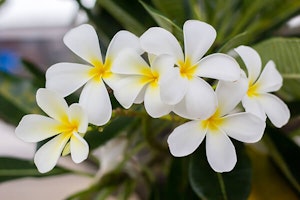
Planting Plumeria in the Ground in Maricopa County
When planting plumeria in the ground, the most important thing to consider is location. SummerWinds Nursery recommends planting plumeria in the Southeast corner of your home, as this provides the plant with afternoon shade in the summer and full sun in the winter. If you choose to plant your plumeria in the ground (instead of in a container,) we recommend that you amend your soil to increase drainage, such as E.B. Stone Organics Citrus & Palm Planting Mix. For more information, speak with one of our Trusted Garden Advisors.
Taking Care of Your Own Plumeria
Who wouldn’t want one of these visually appealing and aromatic plants in a fun and unique container. Makes a perfect addition to your patio!
Visit your local SummerWinds Nursery to get your own plumeria and get some additional planting tips while you’re there. If you like, share your beautiful blooms on Instagram!

